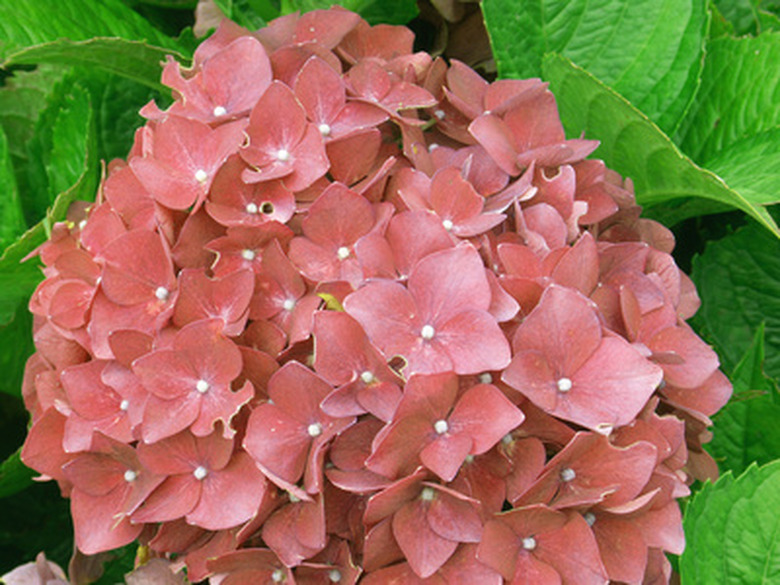How To Plant & Care For Hydrangea Macrophylla
Things Needed
- Hydrangea macrophylla
- Shovel
- Gardening gloves
- Garden hose
- Organic mulch
- Balanced, slow-release fertilizer
- Pruning shears
- Soft twine
- Burlap
Hydrangea macrophylla, commonly called hortensia, florist hydrangea or big-leaf hydrangea, is a popular hydrangea species that blooms with large, showy, globe-shaped flowers during summer. Hydrangea macrophylla plants are somewhat resistant to pests and diseases, but they require a fair amount of care to keep them healthy and blooming. Although Hydrangea macrophylla is hardy down to USDA zone 6 (tolerating temperatures as cold as -5 degrees Fahrenheit), the plant requires some protection to survive prolonged deep freezes during winter.
Step 1
Select a planting site for the Hydrangea macrophylla that's in full to partial sunlight and that has fertile, moist but well-draining soil. Avoid planting the hydrangea in windy locations or where watering is difficult.
Step 2
Dig a hole that's the same depth as the nursery container and plant the hydrangea in it. Water it generously to soak the soil immediately after planting it.
- Hydrangea macrophylla, commonly called hortensia, florist hydrangea or big-leaf hydrangea, is a popular hydrangea species that blooms with large, showy, globe-shaped flowers during summer.
- Select a planting site for the Hydrangea macrophylla that's in full to partial sunlight and that has fertile, moist but well-draining soil.
Step 3
Water the hydrangea deeply and thoroughly once every week when rainfall is less than 1 inch. Water newly planted hydrangeas to soak the soil down to and around the roots once each week during the first spring, summer and early autumn.
Step 4
Spread a 2- to 3-inch-thick layer of organic mulch on the ground around the Hydrangea macrophylla to preserve soil moisture and control weeds. Spread the mulch so it covers the entire root area.
Step 5
Feed the Hydrangea macrophylla once each year in early spring with a slow-release, granular 10-10-10 or 20-20-20 NPK fertilizer at a rate of 2 pounds per 100 square feet of planting bed. Spread the fertilizer granules evenly over the soil around the plant.
Step 6
Prune the flower stems from the hydrangea after the blooms fade in late summer. Remove weaker shoots by cutting them back to the base of the hydrangea plant, allowing a mixture of older, blooming growth and new, stout stems to remain intact.
- Water the hydrangea deeply and thoroughly once every week when rainfall is less than 1 inch.
- Water newly planted hydrangeas to soak the soil down to and around the roots once each week during the first spring, summer and early autumn.
Step 7
Protect the Hydrangea macrophylla in winter by tying the shoots together with soft twine and wrapping them with burlap.
Tip
Plant the hydrangea in early spring, after all chance of frost has passed. Alter the color of the hydrangea's blooms by changing the soil pH. Create blue blooms by making the soil more acidic (low pH) with the addition of iron sulfate to the soil. Add lime to the soil to make the soil more alkaline (high pH) for pink blooms.
Warning
Don't allow the plant to dry out because this can cause a rapid decline of the plant and even death. Water frequently enough to keep the soil from drying out and keep the soil evenly moistened during spring through early autumn.
